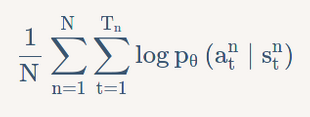-
Notifications
You must be signed in to change notification settings - Fork 1.7k
New issue
Have a question about this project? Sign up for a free GitHub account to open an issue and contact its maintainers and the community.
By clicking “Sign up for GitHub”, you agree to our terms of service and privacy statement. We’ll occasionally send you account related emails.
Already on GitHub? Sign in to your account
Policy Gradient logp(a∣s) 的计算 #20
Comments
|
请参考 Policy Gradient 的代码实现: |
|
这里他是手动算的,不是调用现成交叉熵函数。 看到这个代码,我还有一个疑惑是 相关代码片如下: |
|
|
|
谢谢,类似 至于交叉熵函数,我看 Mofan Zhou 使用的是 |
# to maximize total reward (log_p * R) is to minimize -(log_p * R), and the tf only have minimize(loss)
neg_log_prob = tf.nn.sparse_softmax_cross_entropy_with_logits(logits=all_act, labels=self.tf_acts) # this is negative log of chosen action
# or in this way:
# neg_log_prob = tf.reduce_sum(-tf.log(self.all_act_prob)*tf.one_hot(self.tf_acts, self.n_actions), axis=1)
loss = tf.reduce_mean(neg_log_prob * self.tf_vt) # reward guided loss |
|
谢谢,没注意到注释的部分,结合注释看理解了一些。关于 这一行中的 是和 第四章 策略梯度 中下图一致 我不太理解的是图中红框部分为什么是那样表示,我的理解是 其中 照我这样想的话,代码应该是 而不是 mofan 的 请问是我的理解哪里有问题么? |
|
现在一想,有点忘了为啥当初没理解 tf.log[0.2, 0.5, 0.3] 计算就是依次对 list 里的每个元素求 log。 exp_list = [tf.math.exp(tf.constant(1.0)), tf.math.exp(tf.constant(2.0))]
print(tf.math.log(exp_list))
# tf.Tensor([1. 2.], shape=(2,), dtype=float32)现在反倒没想明白的是为啥是两个行向量相乘,估计只是一种表现形式吧... |





在 第四章 策略梯度 的 Tips 小节上面一点有如下表述:
对于 “TensorFlow 上调用现成函数”,我看到 SO 上有个 How to choose cross-entropy loss in TensorFlow? 这个问题,你建议 PG 这里怎么选呢?
The text was updated successfully, but these errors were encountered: